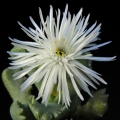




Your support is critical to our success.
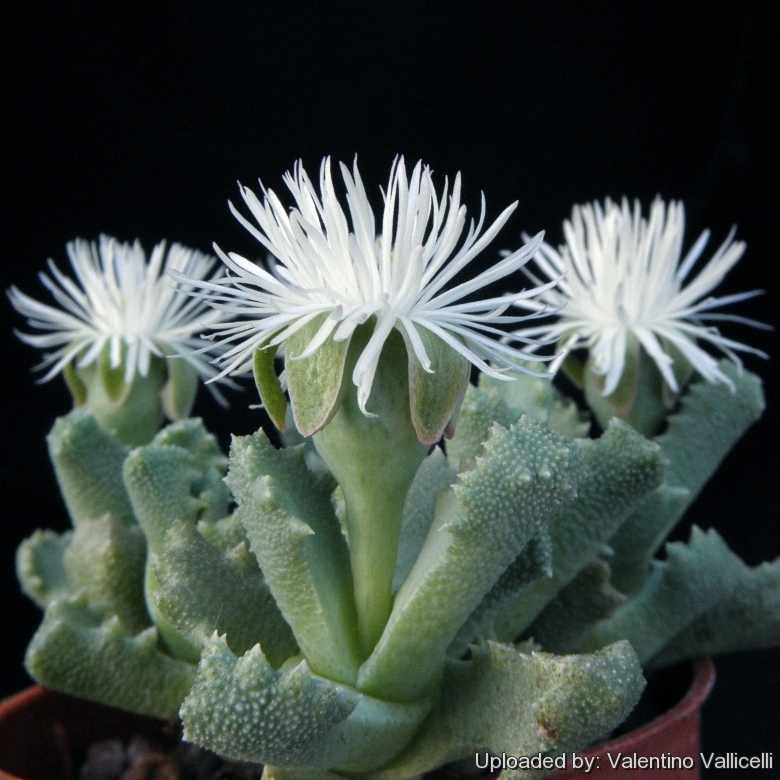
Origin and Habitat: It grows in Bushmanland, Namaqua highlands. Cape Province. South Africa.
Habitat: Dry stony areas.
Synonyms:
- Stomatium alboroseum L. Bolus
Description: Stomatium alboroseumSN|19127]]SN|19126]] is a tiny, night flowering succulent with a bright white or pink 'bottlebrush' flower which is also very fragrant, kind of like coconut wintergreen, its hard to describe and white knobby fleshy leaves. The name Stomatium means 'open mouth' and these attractive little plants are similar in appearance to the other 'mouth' or 'jaw'-like plants in this family, with blunt teeth along the leaf edges.
Similar species: It is related and similar to Stomatium niveumSN|19126]]SN|19127]], but colour range extends to pink.
Habit: It is a tiny, little branched, low growing perennial succulents.
Stems: Absent or very short, each branch bearing 2-4(–6) pairs al leaves.
Leaves: Solid, expanded and incurved towards the apex, greysh-green, surface rough with small white teeth-like warts and with more or less developed marginal teeth.
Flower: Up to 15-18 mm in diameter, with an intense aroma. Petals snow-white to pink. Flower-stalks up to 3 mm. Nectaries basal like in Conophytum.
Blooming time: The flowering period is stated as late autumn to winter. Flowers begin to open only near sunset and close early in the morning. It starts flowering early, just six months from seed to flowers.
Fruits: The fruit is a 5(-6)-locular capsule.
Subspecies, varieties, forms and cultivars of plants belonging to the Stomatium alboroseum group
 Stomatium alboroseum L. Bolus
Stomatium alboroseum L. Bolus Stomatium niveum L. Bolus
Stomatium niveum L. Bolus
Notes: Stomatiums tend to be more grouped with Faucaria-types, but they shows similarities in Aloinopsis/Titanopsis as well. In cultivation Stomatium will hybridize with Titanopsis (day meets night) and Neohenricia.
Bibliography: Major references and further lectures
1) Heidrun E. K. Hartmann (Hrsg.): “Illustrated Handbook of Succulent Plants: Aizoaceae F-Z.” Springer Verlag, Berlin/Heidelberg/New York 2001
2) Gideon Smith u.a. (Hrsg.) “Mesembs of the World: Illustrated Guide to a Remarkable Succulent Group.” Briza Publications, 1998
3) Gustav Schwantes “Zur Systematik der Mesembryanthemen.” In: Zeitschrift für Sukkulentenkunde. volume 2, page 175, 1926
4) Hermann Jacobsen “A handbook of succulent plants: descriptions, synonyms, and cultural details for succulents other than Cactaceae, Volume 1” Blandford Press, 1960
5) James Cullen, Sabina G. Knees, H. Suzanne Cubey “The European Garden Flora Flowering Plants: A Manual for the Identification of Plants Cultivated in Europe, Both Out-of-Doors and Under Glass” Cambridge University Press, 11/ago/2011

Stomatium alboroseum Photo by: Valentino Vallicelli
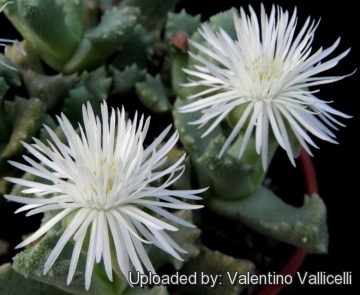
Stomatium alboroseum Photo by: Valentino Vallicelli
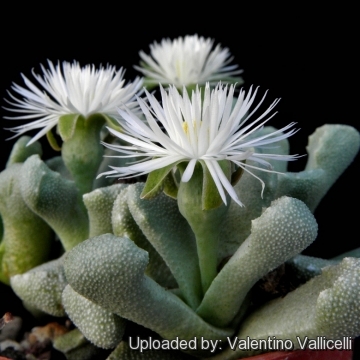
Stomatium alboroseum Photo by: Valentino Vallicelli

Stomatium alboroseum Photo by: Valentino Vallicelli

Stomatium alboroseum Photo by: Valentino Vallicelli
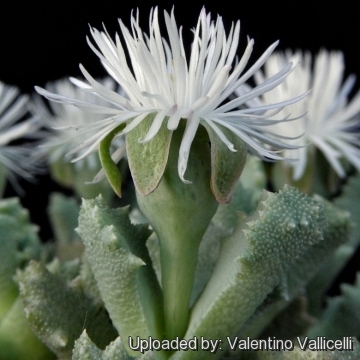
Stomatium alboroseum Photo by: Valentino Vallicelli

Stomatium alboroseum Photo by: Valentino Vallicelli
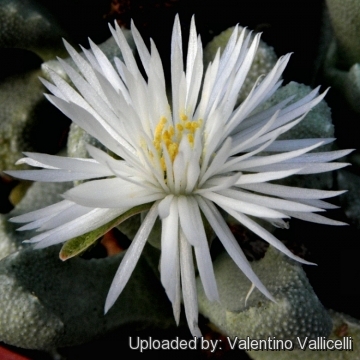
Stomatium alboroseum Photo by: Valentino Vallicelli
Cultivation and Propagation: Stomatium alboroseumSN|19126]]SN|19126]] species which grows in autumn, flowers in winter, and then rests, but in favourable growing conditions it keeps going over the summer too and doesn't need particular care. Stomatium alboroseumSN|19126]]SN|19126]] seems to prefer a fairly dry rest in summer but grows whenever watered. It is easy to grow.
Growing rate: It is vigorous and quick-growing, speedily forming lateral shoots and low mats.
Soil: Requires good drainage as it it is prone to root rot. It can grows outdoor in sunny, dry, rock crevices (protection against winter wet is required) It can also be cultivated in alpine house, in poor, drained soil.
Fertilization: Feed it once during the growing season with a fertilizer specifically formulated for cactus succulents (poor in nitrogen), including all micro nutrients and trace elements diluted to ½ the strength recommended on the label. It thrives in poor soils and need a limited supplies of fertilizer to avoid the plants developing excess vegetation, which is easily attacked by fungal diseases.
Watering: They are not at all delicate and can take some water year-round. Water minimally in winter, only when the plant starts shrivelling, water more abundantly when they are growing in the autumn and spring, but let the soil dry between soaking. An occasional summer soaking is wise. If grown in a container, bottom watering by immersing the container is recommended. It must have very dry atmosphere.
Light: It needs a bright sunny or light shade exposure in winter, but keep cool and partially shaded in summer.
Hardiness: It prefer a very bright situation and require a minimum temperature 0°C (But will take frost and is hardy down to -12° C or less for short periods if is in dry soil ). USDA zones (8-)9-11. The earlier in the year they are planted, the better the chances for winter survival. True with many of the Mesembryanthemaceae.
Uses: They are hardy and they look fine in a cold greenhouse, frame, in containers or outdoor in a rockery.
Pests & diseases: Stomatium alboroseumSN|19126]]SN|19126]] may be attractive to a variety of insects, but plants in good condition should be nearly pest-free, particularly if they are grown in a mineral potting-mix, with good exposure and ventilation. Nonetheless, there are several pests to watch for:
- Red spiders: they may be effectively rubbed up by misting the vulnerable plants every day.
- Mealy bugs: Occasionally mealy bugs develop aerial into the new leaves and flowers with disfiguring results, but the worst types develop underground on the roots and are invisible except by their effects.
- Sciara Flies: Sciara Flies are one of the major problems for seedlings. It is a good practice to mulch your seedlings with a layer of grit, which will strongly discourage the flies.
- Scales, thrips and aphids: This insects are rarely a problem.
It is wise to treat your whole collection with a systemic insecticide twice a year in spring and autumn.
- Rot: Rot it is only a minor problem with mesembs if the plants are watered and “aired” correctly. If they are not, fungicides won't help all that much.
Propagation: Seed in spring or (or rarely) cuttings. To make a cutting twist off a branch with at least a part of roots and permit it to dry out a couple of days, lay it on the soil and insert the stem end partially into the soil. Try to keep the cutting somewhat upright so that the roots are able to grow downward. It is quick and easy from seed. Stomatium will hybridize with Titanopsis (day meets night) and Neohenricia.
| Your Actions | |
|---|---|
| Back to Stomatium index | |
| Back to Aizoaceae index | |
 |
Back to Succulents Encyclopedia index |
Privacy stantement - Terms and conditions - How to cite - About us - Feedback - Donate




